
The genus Anchusa belongs to the borage family (Boraginaceae). It includes about 35 species found growing in Europe, North Africa, South Africa and Western Asia. They are introduced in the United States.
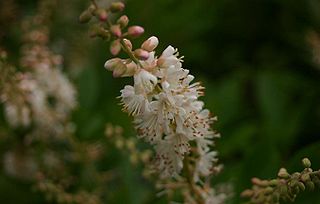
Clethra alnifolia, the coastal sweetpepperbush or summer sweet, is a species of flowering plant in the genus Clethra of the family Clethraceae, native to eastern North America from southern Nova Scotia and Maine south to northern Florida, and west to eastern Texas. It is a deciduous shrub which grows in wetlands, bogs and woodland streams.
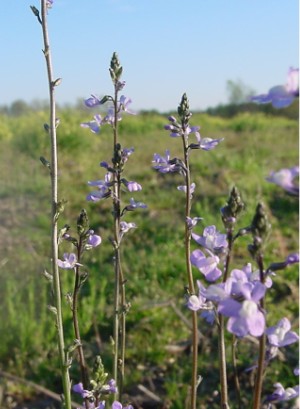
Nuttallanthus canadensis, the blue toadflax, Canada toadflax, or old-field toadflax, is a species of Nuttallanthus in the family Plantaginaceae, native to eastern North America from Ontario east to Nova Scotia and south to Texas and Florida.

Oenothera fruticosa, the narrowleaf evening primrose or narrow-leaved sundrops, is a species of flowering plant in the evening primrose family.
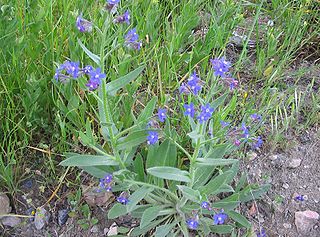
Anchusa azurea is a species of flowering plant in the family Boraginaceae, known by the common names garden anchusa and Italian bugloss. This bristly herbaceous perennial may reach 1.5 m (4.9 ft) tall and 60 cm (24 in) wide. It has straight lance-shaped leaves and petite tubular flowers about 15 millimeters across with five bright violet-blue petals. These flowers, which typically appear in May–July, are edible and attract bees. This species is native to Europe, western Asia, and eastern Maghreb.
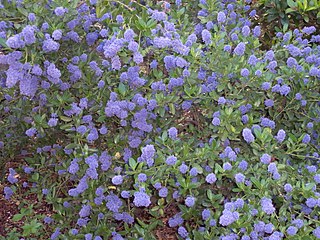
Ceanothus thyrsiflorus, known as blueblossom or blue blossom ceanothus, is an evergreen shrub in the buckthorn family Rhamnaceae that is endemic to Oregon and California in the US. The term 'Californian lilac' is also applied to this and other varieties of ceanothus, though it is not closely related to Syringa, the true lilac.

Gilia capitata is a species of flowering plant in the phlox family known by the common names blue-thimble-flower, bluehead gilia, blue field gilia, and globe gilia.

Cuphea ignea, the cigar plant, cigar flower, firecracker plant, or Mexican cigar, is a species of flowering plant in the genus Cuphea of the family Lythraceae. It is a tropical, densely branched evergreen subshrub. This species, native to Mexico and the West Indies, produces small, tubular, bright red to orange flowers. Each flower is tipped with a thin white rim and two small purple-black petals. The flowers, which are attractive to hummingbirds and butterflies, resemble lit cigars, hence the name ignea, which is Latin for "fiery". The genus name Cuphea comes from the Greek word kyphos which means curved or humped; this is thought to refer to the shape of the seeds. The leaves are small, elliptical and of a bright green colour. It grows to about 60 cm (24 in).

Clematis armandii is a flowering climbing plant of the genus Clematis. Like many members of that genus, it is prized by gardeners for its showy flowers. It is native to much of China and northern Burma. The plant is a woody perennial. It attracts bees, butterflies, and hummingbirds.

Anemonoides blanda, syn. Anemone blanda, the Balkan anemone, Grecian windflower, or winter windflower, is a species of flowering plant in the family Ranunculaceae. The species is native to southeastern Europe and the Middle East. The specific epithet blanda means "mild" or "charming". The genus name is derived from the Greek word anemos, or wind.

Ilex cornuta, commonly known as Chinese holly or horned holly, is a slow-growing, densely foliaged evergreen shrub in the Aquifoliaceae plant family. It is native to eastern China and Korea and attains a height of about 3 metres (9.8 ft). The leaves are usually 5-spined, between 3.5 cm and 10 cm long, oblong and entire. The fruits are red berries, which are larger than those of the European Holly.
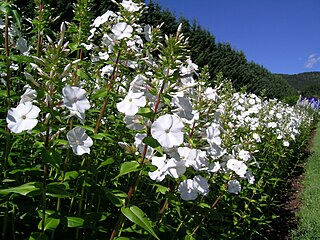
Phlox carolina, the thickleaf phlox, is a species of flowering plant in the family Polemoniaceae. It is an herbaceous perennial growing to 1.2 m (4 ft) tall by 45 cm (18 in) wide, with leaves to 13 cm (5 in) long, and purple or pink flowers in summer. The specific epithet carolina refers to its native habitat in the eastern United States. It grows in woodland edges and openings. Flowers attract bees, hummingbirds, and butterflies.

Eutrochium dubium, also called coastal plain joe pye weed, is a North American flowering plant in the family Asteraceae. It is native to the eastern United States and Canada, primarily the Atlantic coastal plain from Georgia to Nova Scotia.

Isotoma fluviatilis, the swamp isotome or blue star creeper, is a small herbaceous perennial plant in the family Campanulaceae, native to Australia.

Indigofera decora, commonly known as summer wisteria, is a species of shrub native to China and Japan that has since been introduced to Australia and Sri Lanka. A member of the genus Indigofera, its family is Fabaceae and is used primarily for decorative purposes, though it has also been used to make indigo-colored dye.

Symphyotrichum patens, commonly known as late purple aster or spreading aster, is a perennial, herbaceous plant found in the eastern United States.
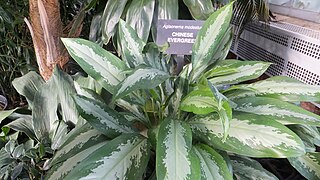
Aglaonema modestum, called Chinese evergreen, green-for-ten-thousand-years, and lily of China, is a species of flowering plant in the genus Aglaonema, native to Bangladesh, Thailand, Laos, Vietnam, and southeast and south-central China. In these areas, it is found in tropical swamps and rainforests.

Heuchera sanguinea, called coral bells, is a species of flowering plant in the genus Heuchera, native to the US states of Arizona and New Mexico, and to northern Mexico. A number of cultivars are commercially available. The Latin specific epithet sanguinea means blood-red, in reference to the color of the flowers. Flowers are deep pink to red, sweetly fragrant, and bell-shaped. Heuchera sanguinea is a perennial herb. The plant attracts bees and hummingbirds.

Plantago virginica, common names hoary plantain and Virginia plantain, is a species of plant native to North America and introduced in Asia. It is listed as a special concern in Connecticut. The Kiowa use it to make garlands or wreaths for old men to wear around their heads during ceremonial dances as a symbol of health. It is commonly found within the continental United States in the majority of states along coastal areas and on roads, though has become an invasive species to eastern China after its introduction c. 1980. It is an annual plant, blooming around the month of May.

Pittosporum heterophyllum, commonly known as Chinese Pittosporum, is a species of plant in the genus Pittosporum. Native to China and Tibet, it is a broadleaf evergreen shrub that grows to a maximum of 8–10 feet (2.4–3.0 m) tall. It has long been grown in gardens ornamentally, especially as a hedge or screen, in temperate gardens for its densely packed green foliage and the fragrant white to yellow flowers it produces in spring. As a landscaping plant, it is known for being more cold hardy than Pittosporum tobira and can be grown in hardiness zones 7-9 on the USDA scale.

























